#cheerfultearful
Explore tagged Tumblr posts
Text
Baby Boomer Memories: Liddle Kiddle Dolls
I was a girly little girl, and loved dolls. (I still do.) Most of my favorite dolls were by Mattel, including Barbie, my beloved Sister Belle, and my last childhood doll, Dancerina. Mattel was a major, major toy maker for the Baby Boomer generation.
Elliot Handler, founder of Mattel (and husband of Ruth Handler, inventor of the Barbie doll!) wanted a line of dolls representing small children in neighborhoods across America. Famed doll sculptor Martha Armstrong Hand, who sculpted other popular dolls including Drowsy (1965) and Cheerful Tearful (1966), made the first ten Kiddles in 1965. They were soft vinyl, with bendable wired legs, painted facial features, and rooted hair that could be brushed and combed. Each came with accessories and a little illustrated “komic” or story booklet.
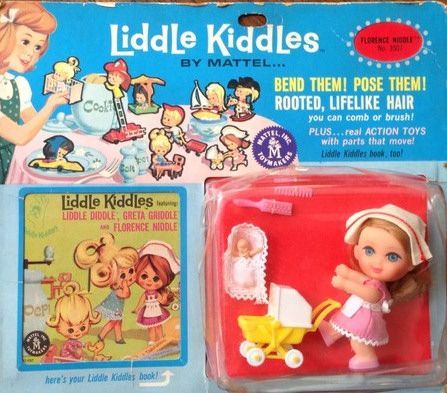
Florence Niddle (1966 - 1967), one of the first 24 Liddle Kiddle dolls.
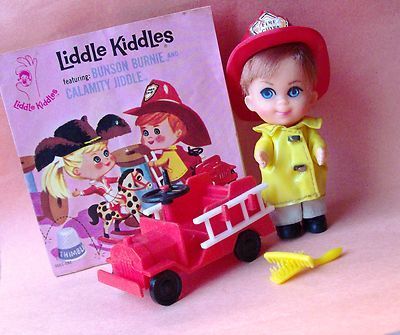
Bunson Burnie (1966 - 1967), one of the original 24 Liddle Kiddles.

Rolly Twiddle (1967) the only African American doll of the first 24 Liddle Kiddles released. She is highly sought after, especially with her original clothes, wagon, pail and shovel, and Komic booklet.
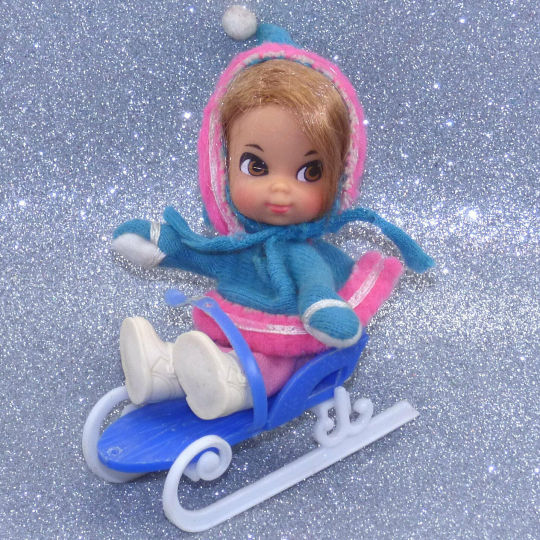
Freezy Sliddle (1967), one of the first 24 Liddle Kiddle dolls.
Liddle Kiddles were introduced at the New York Toy Fair in 1966. The Toy Fair is a buying show, not open to the public, so the dolls hit the market a little later.
I was the fourth grade and turned nine years old in 1967, the perfect age to discover Liddle Kiddle dolls. They were about three inches tall -- much smaller than most dolls of the day -- with playful accessories and outfits. I had so much fun with them!
I had the Storybook Kiddle Liddle Biddle Peep doll (1968), and two Lucky Locket Kiddles. Liddle Biddle Peep was, of course, Little Bo Peep, complete with a chenille sheep and a little shepherd’s crook, a pink dress with paniers, and a matching bonnet. Like all the Storybook Kiddles, Liddle Biddle Peep came with a storybook. She was played with until wires started poking out from her limbs.
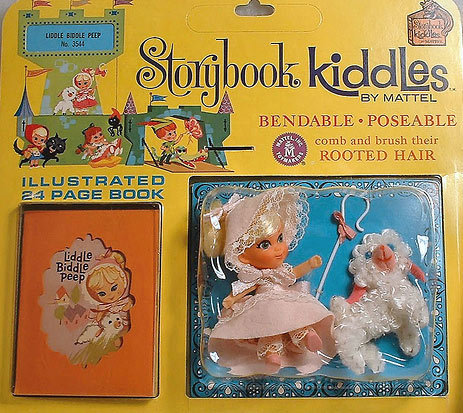
Liddle Biddle Peep from the Storybook Kiddles collection. I loved her.

Sleeping Biddle Storybook Kiddle. I wanted this one so much!
Lucky Locket Kiddles were about two inches tall, and came in wearable plastic lockets with “jeweled” frames and clear plastic bubble fronts. There was a stand on the back that could be pulled out, allowing the locket to be displayed like a picture frame. Unlike their larger siblings, Lucky Locket dolls were not wired, and their clothes were sewn on.
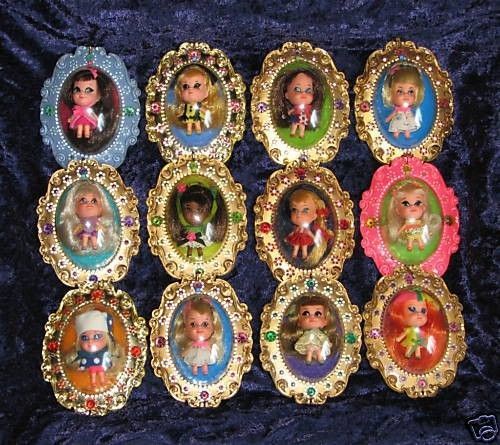
This excellent collection of Lucky Locket Kiddles includes some from the original “Gold Series,” plus some later issues.
My first Lucky Locket Kiddle was Lois Locket, the sole black doll in the Lucky Locket series. I loved her. The summer between fourth and fifth grade, when I was ten, my family drove to San Francisco for a rare vacation. Lois went with me. While we were in San Francisco, we visited a Russian family we had befriended in Japan. When we arrived, we met the newest addition to the family, a darling little girl named Lana but called Kinka. She was five and spoke only Russian, but language was not a barrier. Kinka saw me and immediately pulled me away to play with her. The first thing she did was show me her big sister Tanya’s room. I could tell she attached special importance to Tanya’s make-up and View-Master. I gave Kinka a coin purse from a set I had shaped like dolls. (I was in my “It’s a Small World” phase, and the coin purse dolls represented various nations.) Kinka liked my Lois Locket, and my mother encouraged me to give it to her when we were leaving, so I did. I was not able to replace Lois.
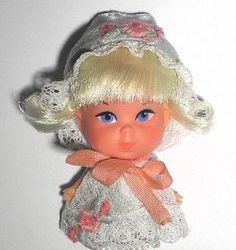
Larky Locket.
My next and last Kiddle was Larky Locket, a sweet blonde baby. I still have her, sans locket, in an ornate, Rococo-inspired little doll cradle. Lois and Larky were both in the first set of seven Lucky Locket Kiddles (1967), known as the “Gold Set,” since the frames were gold. Lois was the only doll repeated in the second set of seven Lockets called the “Pastel” set, (1968) due to the difference in frame colors. I’m almost certain my Lois was from the second set, as I recall her locket frame as pastel green, but I could be wrong. Her clothing was the same in both.

The cover of a Lucky Locket Kiddles set of paper dolls shows photos of the actual dolls inside illustrated frames. Larky Locket, in the center, was the baby of the bunch. I still have her. Lois Locket, just to her right, was the only African-American Lucky Locket Kiddle.
Carrying cases were sold for the dolls. Some of my friends had them. There were also tie-in coloring books and paper dolls.

Liddle Kiddles Klub carrying case, exterior.
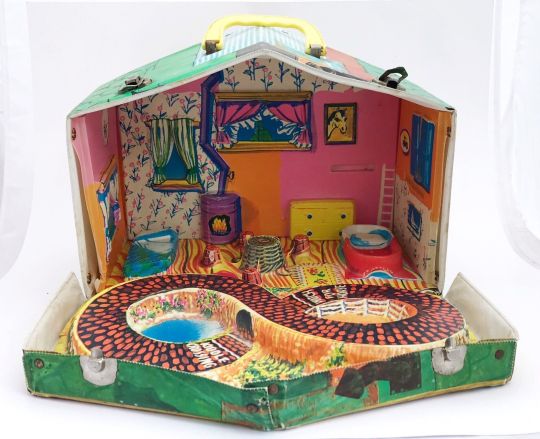
Liddle Kiddles Klub case, interior.

Pink train case-style Liddle Kiddle carrier.

Liddle Kiddle and hat-box style case. Sailor doll Lola Liddle (1966-1967) came with a sailboat. (She is not missing her shoes -- her feet were bare.) The picture on the case shows her with Howard "Biff" Boodle (1966). Lola Liddle and Biff Boodle were among the original 24 Kiddles released. Each was sold with a Komic book that featured them both together.
Mattel released many additional Kiddles, including Kola Kiddles and Kiddle Kolognes. These were two-inch dolls, much like their Locket sisters, but in clear plastic bottles that looked like soft drink bottles and perfume bottles. The tiniest Kiddles were Jewelry Kiddles, from just under to just over one inch high. The largest, four-inch Skedaddle Kiddles, were able to walk, ride vehicles or wave thanks to an internal mechanism. Five Holiday Kiddles (1968 - 1969) representing Christmas, Easter, and Valentine’s Day, had soft bodies and vinyl faces. They could be worn as pins, and the Christmas dolls could also serve as tree ornaments. Four Kiddles n’ Kars dolls (1969 - 1970) wore old-fashioned dresses and drove cars based on early automobiles.

Rosebud (1968 - 1969) from the Kiddle Kolognes collection. The Kologne Kiddles were scented.

Apple Blossom (1968 - 1969) from the Kiddle Kolognes series, shown outside of her bottle.
Some of the other later releases were four tiny (two inch) dolls in animal costumes with yarn hair, the Animiddle Kiddles (1969-1970) that could be worn as pins, and four Zoolery Kiddles (1969-1970). Zoolery Kiddles were four plastic animals (panther, lion, chimpanzee, and bear) rather than children, in plastic circus cages, each attached to a bracelet. The cages could be combined to form a circus train.

Robin Hood and Maid Marion from the Storybook Kiddles Sweethearts Collection.
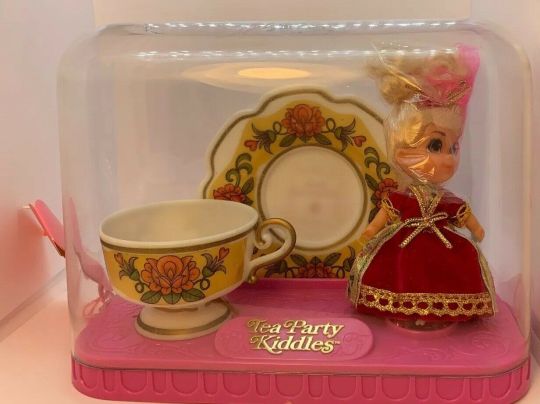
Never opened Lady Crimson from the Tea Party Kiddles series (1969).
From 1968 to 1970 the Storybook Kiddles Sweethearts, tiny but well-detailed pairs of Kiddles portraying star-crossed lovers, such as Romeo and Juliet, and Robin Hood and Maid Marian, were released, along with the Tea Party line in 1969, featuring girls in beautiful gowns, each with a teacup and saucer large enough for human use. This was also the year of the wonderful, whimsical Kozmic Kiddles -- glow-in-the-dark space aliens in flying saucers. I remember Kozmic Kiddles from the Sears Christmas Catalog. How I wanted one of those!

Kozmic Kiddle Greenie Meanie (1969). The Kozmic Kiddles fetch some of the highest prices.
Six Sweet Treat Kiddles with ice cream and lollipop motiifs came out 1969 - 1970. Three Playhouse Kiddles, one set in a kitchen, one in a parlor, and one in a bedroom, were sold only in 1970. Four Liddle Baby Kiddles were also released in 1970. (I was glad to see one of the Liddle Baby Kiddles was African American. For the time, the representation was significant.) I was aware of the Sweet Treats, but otherwise don’t remember most of the later Liddle Kiddles.
A story I read as a child compared growing up to going through a magic door. It closes behind you, but a new door opens. When I was 12, I gradually stopped playing with dolls the way I had before, even though I still liked them. I felt profound sadness for leaving my childhood, but understood it was inevitable, and looked forward to what was ahead. I vowed not to forget what it was like to be a child, and like many creative people, I do remember.
Coincidentally, as my childhood and the 1960s came to a close, so did the heyday of Liddle Kiddles. The rising price of petroleum was bad news for makers of vinyl and plastic products, including toys. Mattel made drastic cuts, and the last Kiddles were released in 1970. ln 1971 production discontinued. (The iconic and perennial best-seller Barbie endured.)
There were a few postscripts in the late 1970s. Lucky Locket Kiddles were reissued 1976 - 1978 with bright color frames, then some final ice cream theme Sweet Treat Kiddles were released in 1979, but otherwise the Liddle Kiddle series was no more. Their influence remains. Liddle Kiddles paved the way for other small dolls, including a Kiddles-like series by Uneeda in the 1980s.
Liddle Kiddles remain very popular with collectors, and there are many on-line resources and collector groups. For quite of few of us, these dolls are a treasured memory.
#liddlekiddle#mattel#barbie#sisterbelle#dancerina#elliothandler#martha armstrong hand#drowsy#cheerfultearful#newyorktoyfair#storybookkiddle#liddlebiddle#liddlebiddlebeep#littlebopeep#luckylocket#luckylocketkiddle#loislocket#black doll#larkylocket#kolakiddle#kolognekiddle#skedaddlekiddle#kozmickiddle#kozmickiddles#teapartykiddle#sears catalog#petroleum#petroleumprice#kiddle collectors#babyboomer memories
198 notes
·
View notes